DevOps Project Report: Comparing Agile and Traditional Methods
VerifiedAdded on 2021/02/20
|7
|1926
|198
Report
AI Summary
This report provides a comprehensive overview of DevOps, contrasting it with traditional and Agile project management methodologies. It explores the core concepts, including the evolution from traditional methods to Agile, and the subsequent emergence of DevOps as an extension of Agile principles. The report delves into the tools and techniques utilized in DevOps, such as cloud computing, automation, and various monitoring tools, with a specific focus on their application in developing a university website. The findings highlight the benefits of DevOps, including increased efficiency, faster deployment, improved software quality, and cost reduction. The report concludes that DevOps is a crucial approach for successful project completion, particularly in the context of software and website development, offering valuable insights for IT professionals and students alike. The study emphasizes the importance of continuous testing, maintenance, and the adoption of advanced tools to enhance project outcomes.

DEVOPS ANOTHER
PROJECT
PROJECT
Paraphrase This Document
Need a fresh take? Get an instant paraphrase of this document with our AI Paraphraser
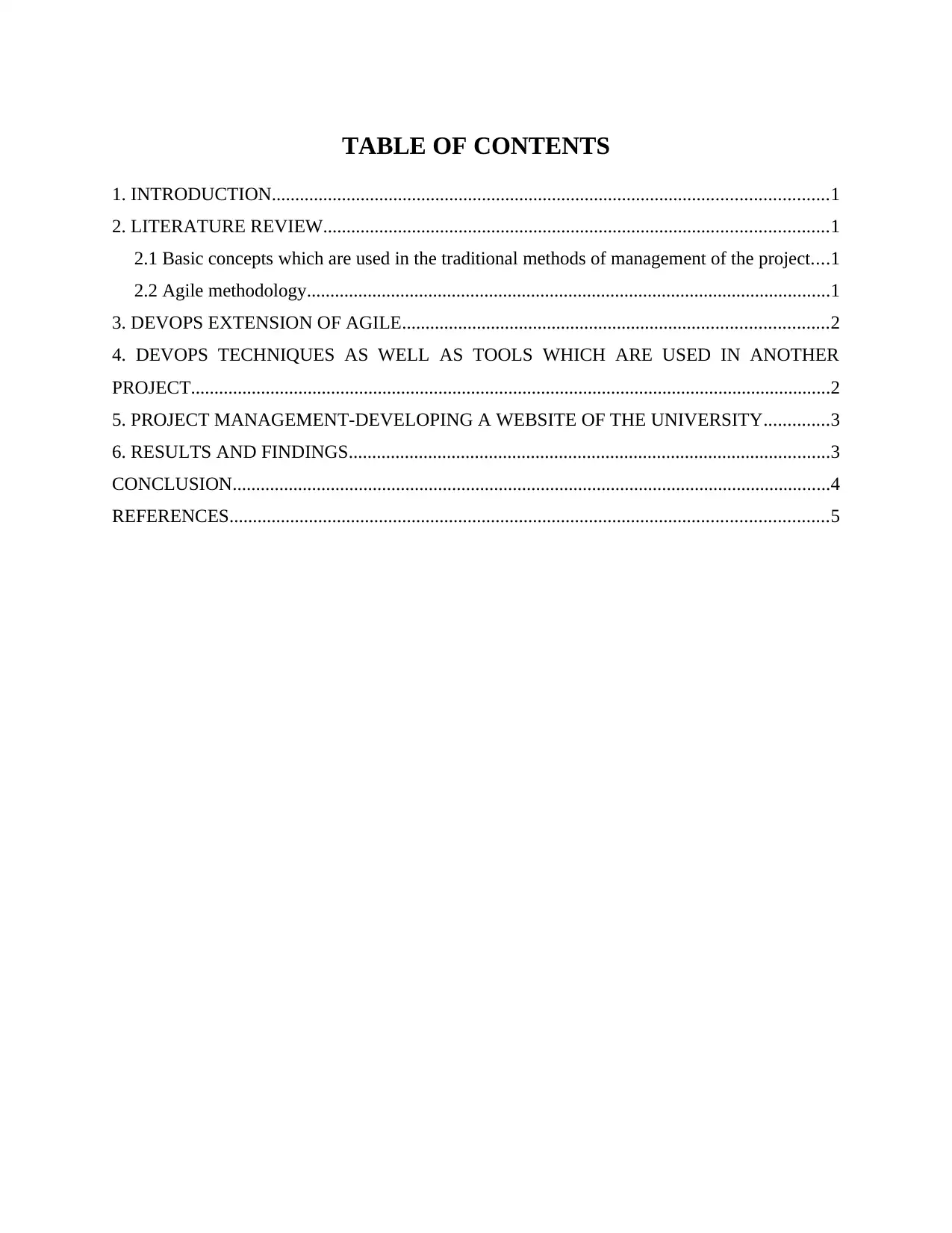
TABLE OF CONTENTS
1. INTRODUCTION.......................................................................................................................1
2. LITERATURE REVIEW............................................................................................................1
2.1 Basic concepts which are used in the traditional methods of management of the project....1
2.2 Agile methodology................................................................................................................1
3. DEVOPS EXTENSION OF AGILE...........................................................................................2
4. DEVOPS TECHNIQUES AS WELL AS TOOLS WHICH ARE USED IN ANOTHER
PROJECT.........................................................................................................................................2
5. PROJECT MANAGEMENT-DEVELOPING A WEBSITE OF THE UNIVERSITY..............3
6. RESULTS AND FINDINGS.......................................................................................................3
CONCLUSION................................................................................................................................4
REFERENCES................................................................................................................................5
1. INTRODUCTION.......................................................................................................................1
2. LITERATURE REVIEW............................................................................................................1
2.1 Basic concepts which are used in the traditional methods of management of the project....1
2.2 Agile methodology................................................................................................................1
3. DEVOPS EXTENSION OF AGILE...........................................................................................2
4. DEVOPS TECHNIQUES AS WELL AS TOOLS WHICH ARE USED IN ANOTHER
PROJECT.........................................................................................................................................2
5. PROJECT MANAGEMENT-DEVELOPING A WEBSITE OF THE UNIVERSITY..............3
6. RESULTS AND FINDINGS.......................................................................................................3
CONCLUSION................................................................................................................................4
REFERENCES................................................................................................................................5
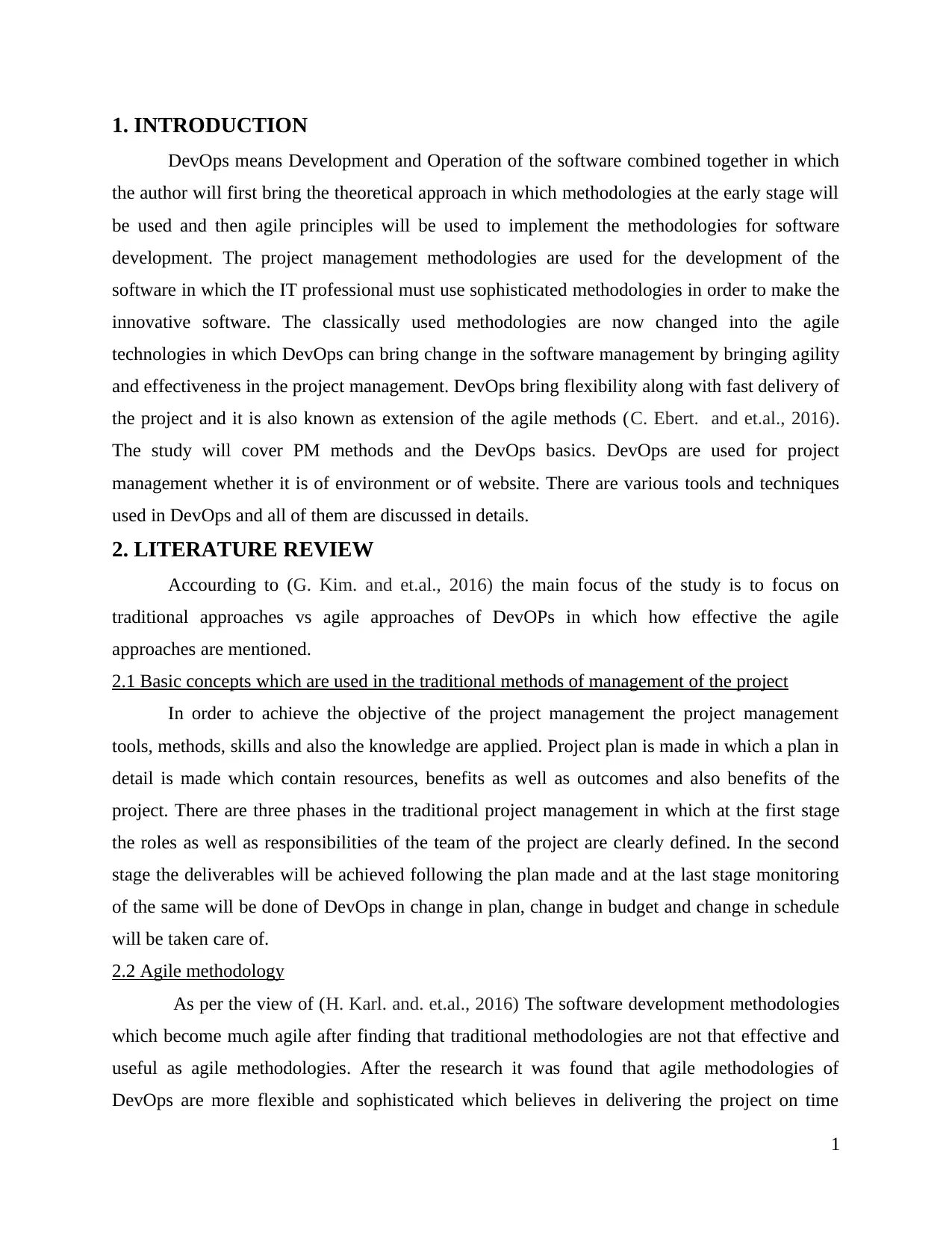
1. INTRODUCTION
DevOps means Development and Operation of the software combined together in which
the author will first bring the theoretical approach in which methodologies at the early stage will
be used and then agile principles will be used to implement the methodologies for software
development. The project management methodologies are used for the development of the
software in which the IT professional must use sophisticated methodologies in order to make the
innovative software. The classically used methodologies are now changed into the agile
technologies in which DevOps can bring change in the software management by bringing agility
and effectiveness in the project management. DevOps bring flexibility along with fast delivery of
the project and it is also known as extension of the agile methods (C. Ebert. and et.al., 2016).
The study will cover PM methods and the DevOps basics. DevOps are used for project
management whether it is of environment or of website. There are various tools and techniques
used in DevOps and all of them are discussed in details.
2. LITERATURE REVIEW
Accourding to (G. Kim. and et.al., 2016) the main focus of the study is to focus on
traditional approaches vs agile approaches of DevOPs in which how effective the agile
approaches are mentioned.
2.1 Basic concepts which are used in the traditional methods of management of the project
In order to achieve the objective of the project management the project management
tools, methods, skills and also the knowledge are applied. Project plan is made in which a plan in
detail is made which contain resources, benefits as well as outcomes and also benefits of the
project. There are three phases in the traditional project management in which at the first stage
the roles as well as responsibilities of the team of the project are clearly defined. In the second
stage the deliverables will be achieved following the plan made and at the last stage monitoring
of the same will be done of DevOps in change in plan, change in budget and change in schedule
will be taken care of.
2.2 Agile methodology
As per the view of (H. Karl. and. et.al., 2016) The software development methodologies
which become much agile after finding that traditional methodologies are not that effective and
useful as agile methodologies. After the research it was found that agile methodologies of
DevOps are more flexible and sophisticated which believes in delivering the project on time
1
DevOps means Development and Operation of the software combined together in which
the author will first bring the theoretical approach in which methodologies at the early stage will
be used and then agile principles will be used to implement the methodologies for software
development. The project management methodologies are used for the development of the
software in which the IT professional must use sophisticated methodologies in order to make the
innovative software. The classically used methodologies are now changed into the agile
technologies in which DevOps can bring change in the software management by bringing agility
and effectiveness in the project management. DevOps bring flexibility along with fast delivery of
the project and it is also known as extension of the agile methods (C. Ebert. and et.al., 2016).
The study will cover PM methods and the DevOps basics. DevOps are used for project
management whether it is of environment or of website. There are various tools and techniques
used in DevOps and all of them are discussed in details.
2. LITERATURE REVIEW
Accourding to (G. Kim. and et.al., 2016) the main focus of the study is to focus on
traditional approaches vs agile approaches of DevOPs in which how effective the agile
approaches are mentioned.
2.1 Basic concepts which are used in the traditional methods of management of the project
In order to achieve the objective of the project management the project management
tools, methods, skills and also the knowledge are applied. Project plan is made in which a plan in
detail is made which contain resources, benefits as well as outcomes and also benefits of the
project. There are three phases in the traditional project management in which at the first stage
the roles as well as responsibilities of the team of the project are clearly defined. In the second
stage the deliverables will be achieved following the plan made and at the last stage monitoring
of the same will be done of DevOps in change in plan, change in budget and change in schedule
will be taken care of.
2.2 Agile methodology
As per the view of (H. Karl. and. et.al., 2016) The software development methodologies
which become much agile after finding that traditional methodologies are not that effective and
useful as agile methodologies. After the research it was found that agile methodologies of
DevOps are more flexible and sophisticated which believes in delivering the project on time
1
⊘ This is a preview!⊘
Do you want full access?
Subscribe today to unlock all pages.

Trusted by 1+ million students worldwide
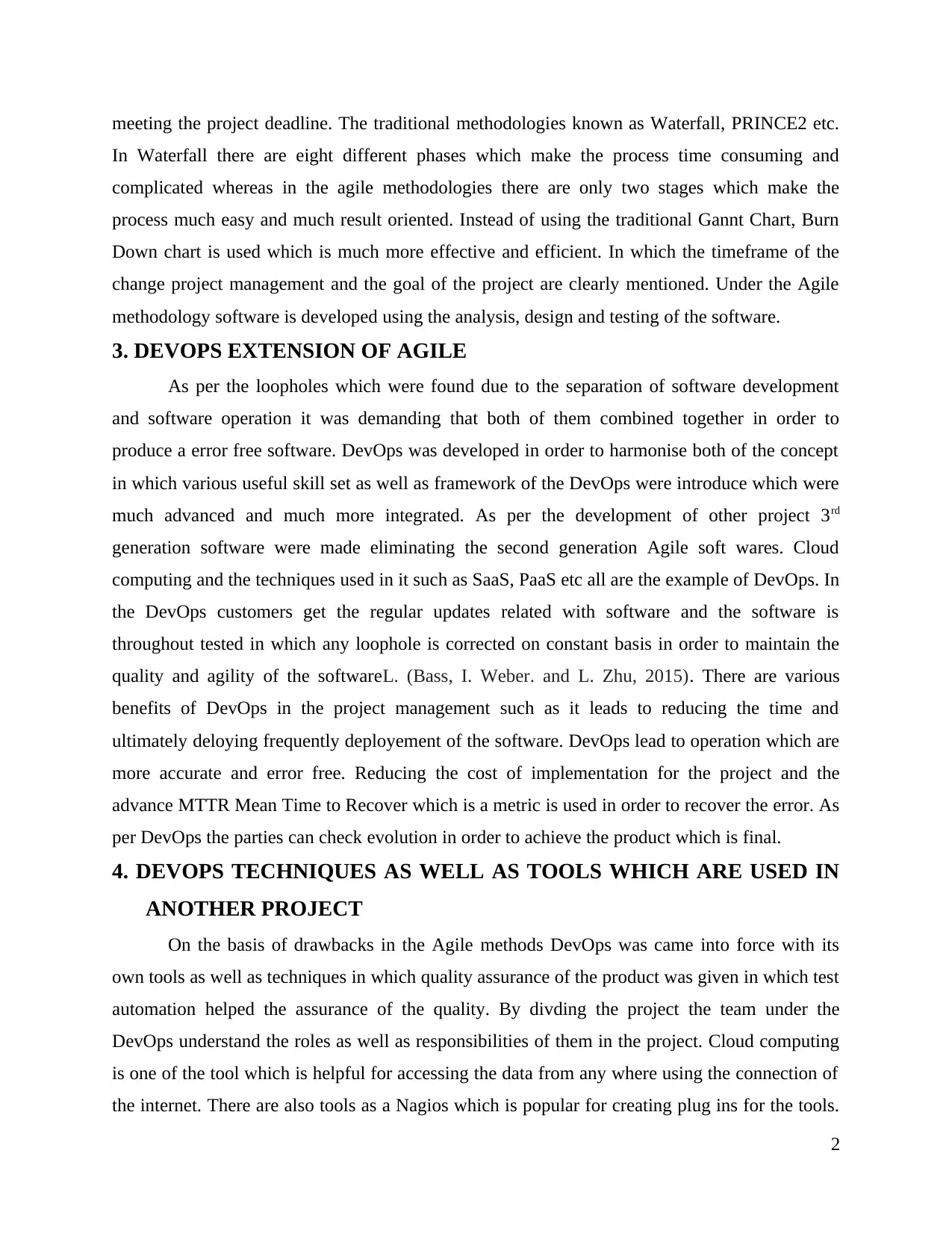
meeting the project deadline. The traditional methodologies known as Waterfall, PRINCE2 etc.
In Waterfall there are eight different phases which make the process time consuming and
complicated whereas in the agile methodologies there are only two stages which make the
process much easy and much result oriented. Instead of using the traditional Gannt Chart, Burn
Down chart is used which is much more effective and efficient. In which the timeframe of the
change project management and the goal of the project are clearly mentioned. Under the Agile
methodology software is developed using the analysis, design and testing of the software.
3. DEVOPS EXTENSION OF AGILE
As per the loopholes which were found due to the separation of software development
and software operation it was demanding that both of them combined together in order to
produce a error free software. DevOps was developed in order to harmonise both of the concept
in which various useful skill set as well as framework of the DevOps were introduce which were
much advanced and much more integrated. As per the development of other project 3rd
generation software were made eliminating the second generation Agile soft wares. Cloud
computing and the techniques used in it such as SaaS, PaaS etc all are the example of DevOps. In
the DevOps customers get the regular updates related with software and the software is
throughout tested in which any loophole is corrected on constant basis in order to maintain the
quality and agility of the softwareL. (Bass, I. Weber. and L. Zhu, 2015). There are various
benefits of DevOps in the project management such as it leads to reducing the time and
ultimately deloying frequently deployement of the software. DevOps lead to operation which are
more accurate and error free. Reducing the cost of implementation for the project and the
advance MTTR Mean Time to Recover which is a metric is used in order to recover the error. As
per DevOps the parties can check evolution in order to achieve the product which is final.
4. DEVOPS TECHNIQUES AS WELL AS TOOLS WHICH ARE USED IN
ANOTHER PROJECT
On the basis of drawbacks in the Agile methods DevOps was came into force with its
own tools as well as techniques in which quality assurance of the product was given in which test
automation helped the assurance of the quality. By divding the project the team under the
DevOps understand the roles as well as responsibilities of them in the project. Cloud computing
is one of the tool which is helpful for accessing the data from any where using the connection of
the internet. There are also tools as a Nagios which is popular for creating plug ins for the tools.
2
In Waterfall there are eight different phases which make the process time consuming and
complicated whereas in the agile methodologies there are only two stages which make the
process much easy and much result oriented. Instead of using the traditional Gannt Chart, Burn
Down chart is used which is much more effective and efficient. In which the timeframe of the
change project management and the goal of the project are clearly mentioned. Under the Agile
methodology software is developed using the analysis, design and testing of the software.
3. DEVOPS EXTENSION OF AGILE
As per the loopholes which were found due to the separation of software development
and software operation it was demanding that both of them combined together in order to
produce a error free software. DevOps was developed in order to harmonise both of the concept
in which various useful skill set as well as framework of the DevOps were introduce which were
much advanced and much more integrated. As per the development of other project 3rd
generation software were made eliminating the second generation Agile soft wares. Cloud
computing and the techniques used in it such as SaaS, PaaS etc all are the example of DevOps. In
the DevOps customers get the regular updates related with software and the software is
throughout tested in which any loophole is corrected on constant basis in order to maintain the
quality and agility of the softwareL. (Bass, I. Weber. and L. Zhu, 2015). There are various
benefits of DevOps in the project management such as it leads to reducing the time and
ultimately deloying frequently deployement of the software. DevOps lead to operation which are
more accurate and error free. Reducing the cost of implementation for the project and the
advance MTTR Mean Time to Recover which is a metric is used in order to recover the error. As
per DevOps the parties can check evolution in order to achieve the product which is final.
4. DEVOPS TECHNIQUES AS WELL AS TOOLS WHICH ARE USED IN
ANOTHER PROJECT
On the basis of drawbacks in the Agile methods DevOps was came into force with its
own tools as well as techniques in which quality assurance of the product was given in which test
automation helped the assurance of the quality. By divding the project the team under the
DevOps understand the roles as well as responsibilities of them in the project. Cloud computing
is one of the tool which is helpful for accessing the data from any where using the connection of
the internet. There are also tools as a Nagios which is popular for creating plug ins for the tools.
2
Paraphrase This Document
Need a fresh take? Get an instant paraphrase of this document with our AI Paraphraser
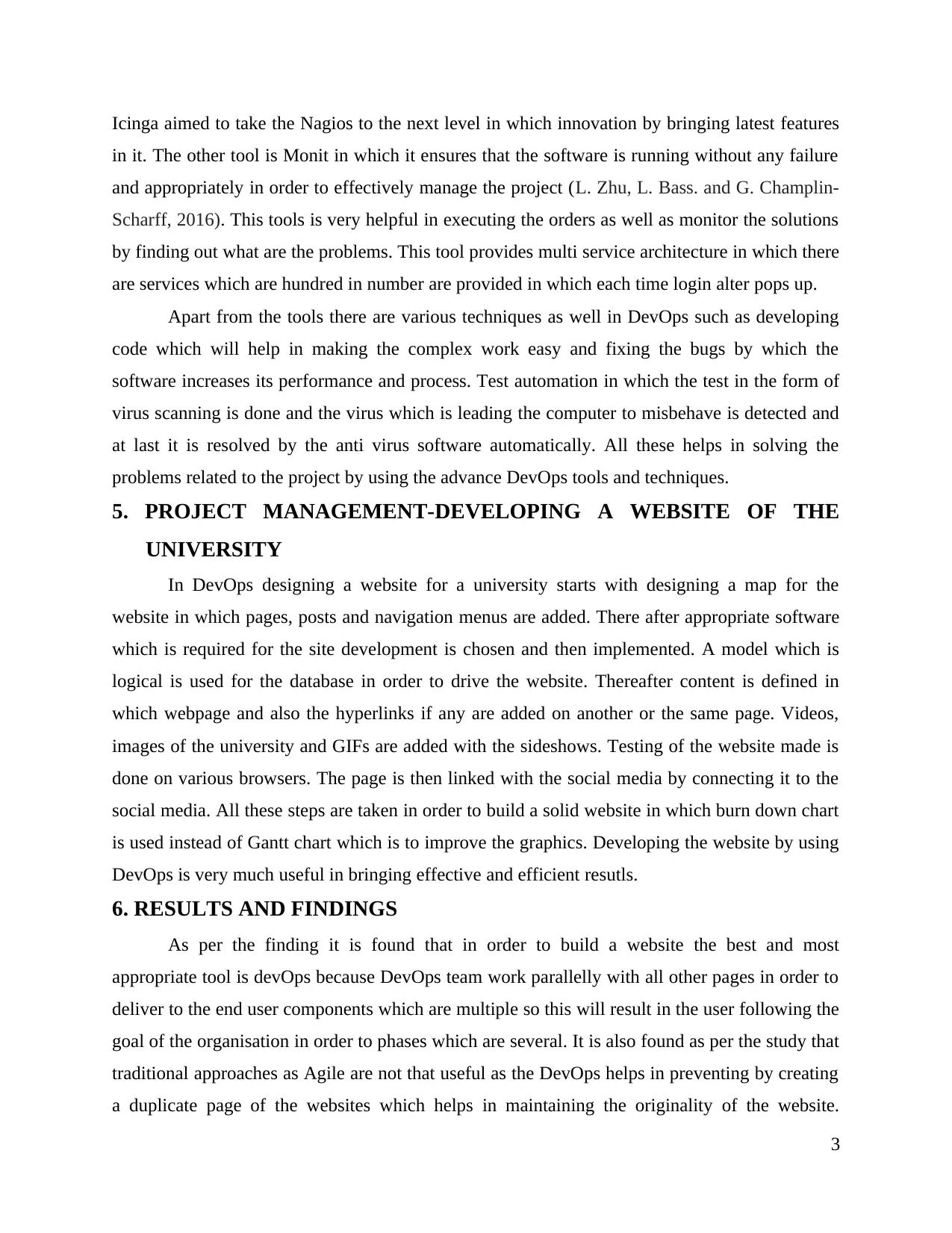
Icinga aimed to take the Nagios to the next level in which innovation by bringing latest features
in it. The other tool is Monit in which it ensures that the software is running without any failure
and appropriately in order to effectively manage the project (L. Zhu, L. Bass. and G. Champlin-
Scharff, 2016). This tools is very helpful in executing the orders as well as monitor the solutions
by finding out what are the problems. This tool provides multi service architecture in which there
are services which are hundred in number are provided in which each time login alter pops up.
Apart from the tools there are various techniques as well in DevOps such as developing
code which will help in making the complex work easy and fixing the bugs by which the
software increases its performance and process. Test automation in which the test in the form of
virus scanning is done and the virus which is leading the computer to misbehave is detected and
at last it is resolved by the anti virus software automatically. All these helps in solving the
problems related to the project by using the advance DevOps tools and techniques.
5. PROJECT MANAGEMENT-DEVELOPING A WEBSITE OF THE
UNIVERSITY
In DevOps designing a website for a university starts with designing a map for the
website in which pages, posts and navigation menus are added. There after appropriate software
which is required for the site development is chosen and then implemented. A model which is
logical is used for the database in order to drive the website. Thereafter content is defined in
which webpage and also the hyperlinks if any are added on another or the same page. Videos,
images of the university and GIFs are added with the sideshows. Testing of the website made is
done on various browsers. The page is then linked with the social media by connecting it to the
social media. All these steps are taken in order to build a solid website in which burn down chart
is used instead of Gantt chart which is to improve the graphics. Developing the website by using
DevOps is very much useful in bringing effective and efficient resutls.
6. RESULTS AND FINDINGS
As per the finding it is found that in order to build a website the best and most
appropriate tool is devOps because DevOps team work parallelly with all other pages in order to
deliver to the end user components which are multiple so this will result in the user following the
goal of the organisation in order to phases which are several. It is also found as per the study that
traditional approaches as Agile are not that useful as the DevOps helps in preventing by creating
a duplicate page of the websites which helps in maintaining the originality of the website.
3
in it. The other tool is Monit in which it ensures that the software is running without any failure
and appropriately in order to effectively manage the project (L. Zhu, L. Bass. and G. Champlin-
Scharff, 2016). This tools is very helpful in executing the orders as well as monitor the solutions
by finding out what are the problems. This tool provides multi service architecture in which there
are services which are hundred in number are provided in which each time login alter pops up.
Apart from the tools there are various techniques as well in DevOps such as developing
code which will help in making the complex work easy and fixing the bugs by which the
software increases its performance and process. Test automation in which the test in the form of
virus scanning is done and the virus which is leading the computer to misbehave is detected and
at last it is resolved by the anti virus software automatically. All these helps in solving the
problems related to the project by using the advance DevOps tools and techniques.
5. PROJECT MANAGEMENT-DEVELOPING A WEBSITE OF THE
UNIVERSITY
In DevOps designing a website for a university starts with designing a map for the
website in which pages, posts and navigation menus are added. There after appropriate software
which is required for the site development is chosen and then implemented. A model which is
logical is used for the database in order to drive the website. Thereafter content is defined in
which webpage and also the hyperlinks if any are added on another or the same page. Videos,
images of the university and GIFs are added with the sideshows. Testing of the website made is
done on various browsers. The page is then linked with the social media by connecting it to the
social media. All these steps are taken in order to build a solid website in which burn down chart
is used instead of Gantt chart which is to improve the graphics. Developing the website by using
DevOps is very much useful in bringing effective and efficient resutls.
6. RESULTS AND FINDINGS
As per the finding it is found that in order to build a website the best and most
appropriate tool is devOps because DevOps team work parallelly with all other pages in order to
deliver to the end user components which are multiple so this will result in the user following the
goal of the organisation in order to phases which are several. It is also found as per the study that
traditional approaches as Agile are not that useful as the DevOps helps in preventing by creating
a duplicate page of the websites which helps in maintaining the originality of the website.
3
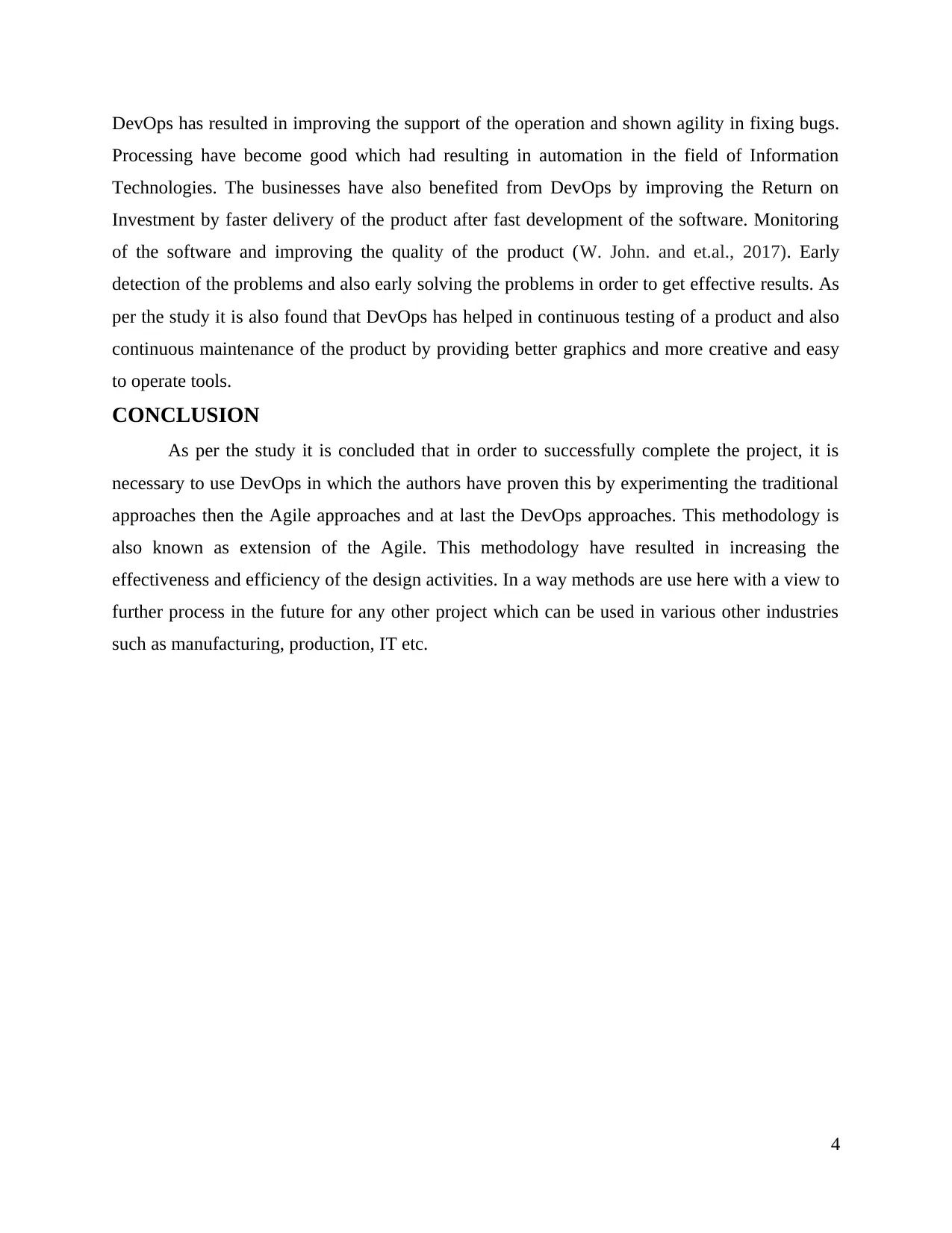
DevOps has resulted in improving the support of the operation and shown agility in fixing bugs.
Processing have become good which had resulting in automation in the field of Information
Technologies. The businesses have also benefited from DevOps by improving the Return on
Investment by faster delivery of the product after fast development of the software. Monitoring
of the software and improving the quality of the product (W. John. and et.al., 2017). Early
detection of the problems and also early solving the problems in order to get effective results. As
per the study it is also found that DevOps has helped in continuous testing of a product and also
continuous maintenance of the product by providing better graphics and more creative and easy
to operate tools.
CONCLUSION
As per the study it is concluded that in order to successfully complete the project, it is
necessary to use DevOps in which the authors have proven this by experimenting the traditional
approaches then the Agile approaches and at last the DevOps approaches. This methodology is
also known as extension of the Agile. This methodology have resulted in increasing the
effectiveness and efficiency of the design activities. In a way methods are use here with a view to
further process in the future for any other project which can be used in various other industries
such as manufacturing, production, IT etc.
4
Processing have become good which had resulting in automation in the field of Information
Technologies. The businesses have also benefited from DevOps by improving the Return on
Investment by faster delivery of the product after fast development of the software. Monitoring
of the software and improving the quality of the product (W. John. and et.al., 2017). Early
detection of the problems and also early solving the problems in order to get effective results. As
per the study it is also found that DevOps has helped in continuous testing of a product and also
continuous maintenance of the product by providing better graphics and more creative and easy
to operate tools.
CONCLUSION
As per the study it is concluded that in order to successfully complete the project, it is
necessary to use DevOps in which the authors have proven this by experimenting the traditional
approaches then the Agile approaches and at last the DevOps approaches. This methodology is
also known as extension of the Agile. This methodology have resulted in increasing the
effectiveness and efficiency of the design activities. In a way methods are use here with a view to
further process in the future for any other project which can be used in various other industries
such as manufacturing, production, IT etc.
4
⊘ This is a preview!⊘
Do you want full access?
Subscribe today to unlock all pages.

Trusted by 1+ million students worldwide
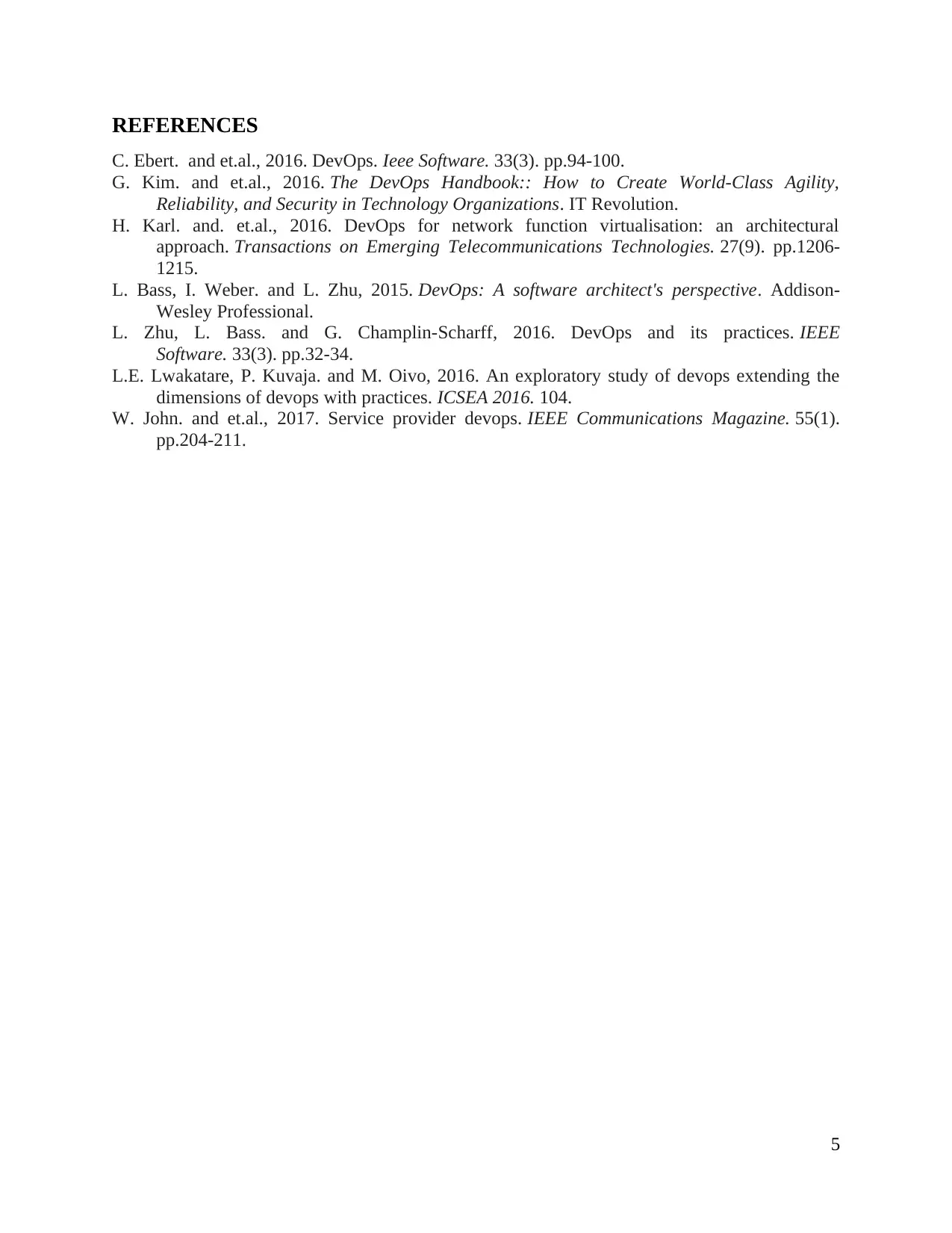
REFERENCES
C. Ebert. and et.al., 2016. DevOps. Ieee Software. 33(3). pp.94-100.
G. Kim. and et.al., 2016. The DevOps Handbook:: How to Create World-Class Agility,
Reliability, and Security in Technology Organizations. IT Revolution.
H. Karl. and. et.al., 2016. DevOps for network function virtualisation: an architectural
approach. Transactions on Emerging Telecommunications Technologies. 27(9). pp.1206-
1215.
L. Bass, I. Weber. and L. Zhu, 2015. DevOps: A software architect's perspective. Addison-
Wesley Professional.
L. Zhu, L. Bass. and G. Champlin-Scharff, 2016. DevOps and its practices. IEEE
Software. 33(3). pp.32-34.
L.E. Lwakatare, P. Kuvaja. and M. Oivo, 2016. An exploratory study of devops extending the
dimensions of devops with practices. ICSEA 2016. 104.
W. John. and et.al., 2017. Service provider devops. IEEE Communications Magazine. 55(1).
pp.204-211.
5
C. Ebert. and et.al., 2016. DevOps. Ieee Software. 33(3). pp.94-100.
G. Kim. and et.al., 2016. The DevOps Handbook:: How to Create World-Class Agility,
Reliability, and Security in Technology Organizations. IT Revolution.
H. Karl. and. et.al., 2016. DevOps for network function virtualisation: an architectural
approach. Transactions on Emerging Telecommunications Technologies. 27(9). pp.1206-
1215.
L. Bass, I. Weber. and L. Zhu, 2015. DevOps: A software architect's perspective. Addison-
Wesley Professional.
L. Zhu, L. Bass. and G. Champlin-Scharff, 2016. DevOps and its practices. IEEE
Software. 33(3). pp.32-34.
L.E. Lwakatare, P. Kuvaja. and M. Oivo, 2016. An exploratory study of devops extending the
dimensions of devops with practices. ICSEA 2016. 104.
W. John. and et.al., 2017. Service provider devops. IEEE Communications Magazine. 55(1).
pp.204-211.
5
1 out of 7
Related Documents
Your All-in-One AI-Powered Toolkit for Academic Success.
+13062052269
info@desklib.com
Available 24*7 on WhatsApp / Email
![[object Object]](/_next/static/media/star-bottom.7253800d.svg)
Unlock your academic potential
Copyright © 2020–2025 A2Z Services. All Rights Reserved. Developed and managed by ZUCOL.




